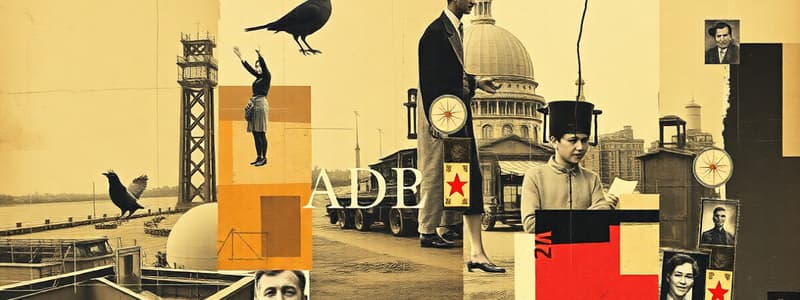Podcast
Questions and Answers
Which term refers to the emotional or attitude conveyed by a poem's language and structure?
Which term refers to the emotional or attitude conveyed by a poem's language and structure?
- Tone (correct)
- Theme
- Allusion
- Mood
What does symbolism in poetry primarily involve?
What does symbolism in poetry primarily involve?
- Describing the poem's structure and form
- Creating a specific rhythm or rhyme scheme
- Referencing cultural or historical figures
- Representing something deeper beyond the literal meaning (correct)
What is the term for the central message or idea explored in a poem?
What is the term for the central message or idea explored in a poem?
- Stanza
- Tone
- Form
- Theme (correct)
Which of the following best defines a stanza in poetry?
Which of the following best defines a stanza in poetry?
Which aspect does not contribute to the mood of a poem?
Which aspect does not contribute to the mood of a poem?
What defines mass media in contrast to other forms of communication?
What defines mass media in contrast to other forms of communication?
Which of the following is NOT considered a form of print media?
Which of the following is NOT considered a form of print media?
What is the primary characteristic that separates digital media from traditional forms of media?
What is the primary characteristic that separates digital media from traditional forms of media?
Which meter is characterized by five pairs of alternating stressed and unstressed syllables?
Which meter is characterized by five pairs of alternating stressed and unstressed syllables?
What does figurative language enhance in poetry?
What does figurative language enhance in poetry?
What type of rhyme involves a partial match or similarity of sounds?
What type of rhyme involves a partial match or similarity of sounds?
How is a simile defined in literary terms?
How is a simile defined in literary terms?
Which element of poetry involves the recurrence of a stressed and unstressed pattern?
Which element of poetry involves the recurrence of a stressed and unstressed pattern?
Flashcards
Media
Media
Covers a broad range of communication methods, including television, radio, newspapers, and the internet.
Mass Media
Mass Media
Forms of communication designed to reach a large audience simultaneously.
Print Media
Print Media
Publications using printed words and images to spread information.
Broadcast Media
Broadcast Media
Signup and view all the flashcards
Digital Media
Digital Media
Signup and view all the flashcards
Meter
Meter
Signup and view all the flashcards
Rhyme
Rhyme
Signup and view all the flashcards
Rhythm
Rhythm
Signup and view all the flashcards
Personification
Personification
Signup and view all the flashcards
Allusion
Allusion
Signup and view all the flashcards
Symbolism
Symbolism
Signup and view all the flashcards
Tone
Tone
Signup and view all the flashcards
Mood
Mood
Signup and view all the flashcards
Study Notes
Media Terms
- Media: A general term encompassing various forms of communication, including television, radio, print (newspapers, magazines), film, internet, and social media platforms. It involves the technology and processes used to disseminate information and create mass communication.
- Mass Media: Channels designed to reach a large audience simultaneously, contrasting with individual or small-group communication.
- Print Media: Publications spreading information through printed words and images. This includes newspapers, magazines, journals, and books.
- Broadcast Media: Using electronic signals (radio waves or television signals) to transmit information to a large audience. Examples include television, radio, and streaming services.
- Digital Media: Various media presented and distributed digitally. This increasingly prominent form includes websites, social media, and online gaming.
- New Media: Media technologies and content emerging from late 20th-century advancements, characterized by interactivity, user-generated content, and digital distribution. This includes social media platforms, blogs, and online forums.
Poetry Terms
- Meter: A pattern of stressed and unstressed syllables in a line of poetry, creating rhythm. Measured by arranging units of stressed and unstressed syllables (e.g., iambic pentameter, trochaic octameter).
- Rhyme: The similarity or identity of sounds at the end of lines of poetry. Can be exact (perfect rhyme) or slant (near rhyme) — e.g., "delight" and "light," or "love" and "move."
- Rhythm: The recurrence of a pattern of stressed and unstressed syllables throughout a poem, creating a musical effect. The placement and emphasis of stressed and unstressed syllables contribute to rhythm and influence meaning.
- Imagery: Vivid language appealing to the five senses, creating sensory experiences for the reader and evoking emotions.
- Figurative Language: Non-literal language enhancing meaning or effect. Examples include metaphor, simile, personification, and allusion.
- Metaphor: A comparison of two unlike things without using "like" or "as", establishing a direct connection.
- Simile: A comparison of two unlike things using "like" or "as".
- Personification: Giving human qualities to inanimate objects or abstract ideas.
- Allusion: A reference to a well-known person, place, event, literary work, or work of art.
- Symbolism: When something represents something else, conveying deeper meanings beyond the literal.
- Tone: The emotional or attitude conveyed by a poem's language, structure, and imagery (e.g., joyful, serious, sarcastic).
- Mood: The feeling evoked in the reader by a poem, often created through imagery and tone. Mood can differ from tone.
- Theme: The central message or idea explored in a poem; a poem may have multiple themes.
- Stanza: A group of lines forming a unit, often separated by space. Stanza structure affects rhythm and meaning.
- Structure: The arrangement of a poem's elements, including rhyme scheme, meter, stanza structure and form.
- Form: The specific structure or pattern of a poem, like sonnet, ode, ballad, sestina, or haiku, each with distinct rules, rhythm, or patterns.
Studying That Suits You
Use AI to generate personalized quizzes and flashcards to suit your learning preferences.




